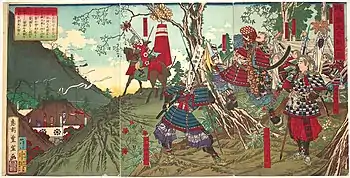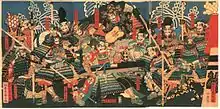Battle of Shizugatake
The Battle of Shizugatake (賤ヶ岳の戦い, Shizugatake no Tatakai) was a battle of the Sengoku period of Japan fought between Toyotomi Hideyoshi (then Hashiba Hideyoshi) and Shibata Katsuie in Shizugatake, Ōmi Province in May 1583. Katsuie supported Oda Nobutaka's claim as successor of Oda Nobunaga in a succession dispute within the Oda clan that benefitted Hideyoshi.
| Battle of Shizugatake | |||||||
|---|---|---|---|---|---|---|---|
| Part of the Sengoku period | |||||||
 Ukiyo-e print of the Battle of Shizugatake by Utagawa Toyonobu | |||||||
| |||||||
| Belligerents | |||||||
| Forces of Hashiba Hideyoshi and Oda Nobukatsu | Forces of Shibata Katsuie and Oda Nobutaka | ||||||
| Commanders and leaders | |||||||
|
Hashiba Hideyoshi Nakagawa Kiyohide † Horio Yoshiharu Ikoma Chikamasa Takayama Ukon Ōtani Yoshitsugu |
Shibata Katsuie † Sakuma Morimasa † Shibata Katsutoyo Maeda Toshiie | ||||||
| Strength | |||||||
| 50,000 men | 27,000 men | ||||||
Katsuie and Sakuma Morimasa attacked fortifications loyal to Hideyoshi at Shizugatake, defeating Nakagawa Kiyohide, but the other sieges stalled. Katsuie ordered Sakuma to retreat but was ignored, and Hideyoshi launched a surprise counterattack that routed Sakuma and forced him to retreat. Hideyoshi pursued Sakuma and successfully besieged Kitanosho Castle which led to the suicide of Katsuie and Oichi.
The Battle of Shizugatake allowed Hideyoshi to consolidate his position as Oda Nobunaga's successor, and was one of the last challenges to his rule along with the Battle of Komaki and Nagakute in 1584. George Sansom states the Battle of Shizugatake "must be regarded as one of the decisive battles in Japanese history."[1]
Background
In June 1582, Oda Nobunaga, the most powerful daimyō in Japan, and his eldest son and heir Oda Nobutada were killed at the Honno-ji Incident after being betrayed by Akechi Mitsuhide. Their surprise deaths created a power vacuum and a succession crisis within the Oda clan. Nobunaga's second and third eldest sons, Oda Nobukatsu and Oda Nobutaka, respectively, began to quarrel over who would succeed him. Nobunaga's retainer and general Hashiba Hideyoshi (later known as Toyotomi Hideyoshi) summoned a council to Kiyosu Castle to settle the succession issue. However, the council declared that Nobutada's 3-year-old son Oda Hidenobu was the rightful heir. Hideyoshi, having defeated Akechi Mitsuhide at the Battle of Yamazaki and with Nobunaga's heir being an infant, was in a very strong position to unofficially succeed Nobunaga himself. Shibata Katsuie, one of Nobunaga's trusted generals, challenged Hideyoshi by changing his initial support for Hidenobu to supporting Nobutaka's claim to the lordship.
Battle

In May 1583, Katsuie coordinated a number of simultaneous attacks on Shizugatake, a series of forts in northern Ōmi Province, located in present-day Nagahama, Shiga Prefecture. These forts, Iwasaki-yama, Tagami, and Shizugatake, were held by Hideyoshi's generals including Nakagawa Kiyohide and Takayama Ukon. Katsuie's nephew Sakuma Morimasa attacked these forts on his orders, taking Iwasaki-yama and killing Nakagawa, but Shizugatake's defenses held. On hearing that Hideyoshi had made camp at Ōgaki with a large mounted force of 20,000 men, Katsuie ordered Sakuma Morimasa to withdraw his troops to Ōiwa. Sakuma did not heed Katsuie's orders, calculating the castle would fall before Hideyoshi's army, assumed to be at least three days away, could arrive to relieve them.[1][2] However, Hideyoshi led his men on a forced march through the night, covering nearly 50 miles in 6 hours, and linked up with the defenders of Tagami. Sakuma ordered his men to break the siege lines and prepare to defend themselves, but Hideyoshi's army pushed Sakuma's forces into a rout.[2][1]
Hideyoshi pursued Sakuma and his forces back to Katsuie's fortress at Kitanosho Castle in Echizen Province, located within present-day Fukui. Hideyoshi's men seized the castle after three days, but not before Katsuie killed members of his household including his wife, Oda Nobunaga's sister Oichi, then setting the castle keep on fire and committing seppuku.[1][2][3] Sakuma was captured by Hideyoshi's forces and beheaded.
Aftermath

As a result of the battle, Oichi's young daughters with Azai Nagamasa (Katsuie's step-daughters) were allowed to leave Kitanosho Castle unscathed and became Hideyoshi's adoptive daughters. Nobutaka was soon pressured by both Hideyoshi and Nobukatsu into committing suicide, eliminating him from the competition. Nobutaka wrote a death poem cursing Hideyoshi and implying that he had been involved in his father Oda Nobunaga's death.
Hideyoshi had now consolidated his position and most of his influence over the Oda clan, but would continue to face competition from Nobukatsu, who had allied himself with Tokugawa Ieyasu, until the Battle of Komaki and Nagakute in 1584.
Seven Spears of Shizugatake
Hideyoshi's chief seven generals in the battle at Shizugatake earned a great degree of fame and honor, and came to be known as the shichi-hon yari or "Seven Spears of Shizugatake". Among these generals were men who would later become some of Hideyoshi's closest retainers, such as Katō Kiyomasa.[2]
The Seven Spears of Shizugatake were the following Samurai:
- Fukushima Masanori (1561–1624)
- Hirano Nagayasu (1559–1628)
- Kasuya Takenori (1562–1607)
- Katagiri Katsumoto (1556–1615)
- Katō Kiyomasa (1562–1611)
- Katō Yoshiaki (1563–1631)
- Wakizaka Yasuharu (1554–1626)
References
- Sansom, George (1961). A History of Japan, 1334-1615. Stanford: Stanford University Press. p. 311-313. ISBN 0804705259.
- Turnbull, Stephen (1998). The Samurai Sourcebook. London: Cassell & Co. p. 234. ISBN 9781854095237.
- Turnbull, S.R. (1977). The Samurai. New York: MacMillan Publishing Co., Inc. pp. 168–171. ISBN 0026205408.
- Black, Jeremy (2008). Great Military Leaders and their Campaigns Thamsen & Hudson Ltd, London
- De Lange, William. Samurai Battles: The Long Road to Unification. Toyp Press (2020) ISBN 978-949-2722-232